Effects of Thermal Annealing on the Characteristics of High Frequency FBAR Devices
Abstract
1. Introduction
2. Materials and Methods
3. Results
4. Conclusions
Author Contributions
Funding
Institutional Review Board Statement
Informed Consent Statement
Data Availability Statement
Acknowledgments
Conflicts of Interest
References
- Nolan, P.; Auer, S.; Spehar, A.; Oplatowska-Stachowiak, M.; Campbell, K. Evaluation of mass sensitive micro-array biosensors for their feasibility in multiplex detection of low molecular weight toxins using mycotoxins as model compounds. Talanta 2021, 222, 1–12. [Google Scholar] [CrossRef] [PubMed]
- Wang, L.; Lin, A.; Kim, E.S. Miniature sensing system with FBAR-based oscillators and frequency shift detector. IEEE Sens. J. 2018, 18, 7633–7637. [Google Scholar] [CrossRef]
- Zhao, J.H.; Xing, Y.H.; Han, J.; Lin, W.K.; Yun, X.F.; Sun, Y.H.; Zhou, X.; Wang, Z.M.; Cao, X.; Zhang, B.S.; et al. The research of dual-mode film bulk acoustic resonator for enhancing temperature sensitivity. Semicond. Sci. Technol. 2021, 36, 1–8. [Google Scholar] [CrossRef]
- Ruby, R.C.; Radley, P.B.; Shmyansky, Y.O.; Chien, A.; Larson, J.D., III. Thin film bulk wave acoustic resonator (FBAR) for wireless applications. In Proceedings of the IEEE Ultrasonics Symposium. Proceedings. An International Symposium, San Juan, PR, USA, 22–25 October 2000; pp. 813–821. [Google Scholar]
- Afzal, A.; Iqbal, N.; Mujahid, A.; Schirhagl, R. Advanced vapor recognition materials for selective and fast responsive surface acoustic wave sensors: A review. Anal. Chim. Acta 2013, 787, 36–49. [Google Scholar] [CrossRef]
- Serhane, R.; Abdelli-Messaci, S.; Lafane, S.; Khales, H.; Aouimeur, W.; Hassein-Bey, A.; Boutkedjirt, T. Pulsed laser deposition of piezoelectric ZnO thin films for bulk acoustic wave devices. Appl. Surf. Sci. 2014, 288, 572–578. [Google Scholar] [CrossRef]
- Zhang, X.; Xu, W.C.; Chae, J. Temperature effects on a high Q FBAR in liquid. Sens. Actuator A Phys. 2011, 166, 264–268. [Google Scholar] [CrossRef]
- Shealy, J.B.; Hodge, M.D.; Patel, P.; Vetury, R.; Feldman, A.Y.; Gibb, S.R.; Boomgarden, M.D.; Lewis, M.P.; Shealy, J.B.; Shealy, J.R. Single crystal AlGaN bulk acoustic wave resonators on silicon substrates with high electromechanical coupling. In Proceedings of the IEEE Radio Frequency Integrated Circuits Symposium (RFIC), San Francisco, CA, USA, 22–24 May 2016; pp. 103–106. [Google Scholar]
- Uehara, M.; Mizuno, T.; Aida, Y.; Yamada, H.; Umeda, K.; Akiyama, M. Increase in the piezoelectric response of scandium-doped gallium nitride thin films sputtered using a metal interlayer for piezo MEMS. Appl. Phys. Lett. 2019, 114, 1–5. [Google Scholar] [CrossRef]
- Schneider, M.; DeMiguel-Ramos, M.; Flewitt, A.J.; Iborra, E.; Schmid, U. Scandium aluminum nitride-based film bulk acoustic resonators. Proceedings 2017, 1, 305. [Google Scholar] [CrossRef]
- Wei, C.L.; Chen, Y.C.; Li, S.R.; Cheng, C.C.; Kao, K.S.; Chung, C.J. Effects of reflecting layers on resonance characteristics of a solidly mounted resonator with 1/4 𝜆 mode configuration. Appl. Phys. A 2010, 99, 271–278. [Google Scholar] [CrossRef]
- Chen, Y.C.; Chang, W.T.; Kao, K.S.; Yang, C.H.; Cheng, C.C. The liquid sensor using thin film bulk acoustic resonator with c-axis tilted AlN films. J. Nanomater. 2013, 2013, 245095. [Google Scholar] [CrossRef]
- Sharma, G.; Liljeholm, L.; Enlund, J.; Bjurstrom, J.; Katardjiev, I.; Hjort, K. Fabrication and characterization of a shear mode AlN solidly mounted resonator-silicone microfluidic system for in-liquid sensor applications. Sens. Actuator A Phys. 2010, 159, 111–116. [Google Scholar] [CrossRef]
- Mirea, T.; Clement, M.; Olivares, J.; Iborra, E. Assessment of the absolute mass attachment to an AlN-based solidly mounted resonator using a single shear mode. IEEE Electron Device Lett. 2020, 41, 609–612. [Google Scholar] [CrossRef]
- Qin, L.F.; Chen, Q.M.; Cheng, H.B.; Wang, Q.M. Analytical study of dual-mode thin film bulk acoustic resonators (FBARs) based on ZnO and AlN films with tilted c-axis orientation. IEEE Trans. Ultrason. Ferroelectr. Freq. Control 2010, 57, 1840–1853. [Google Scholar] [PubMed]
- Sun, P.; Chen, Y.R.; Tang, T.T.; Shen, J.; Liu, X.; Yang, X.M.; Gao, C. Effect of c-axis tilted orientation ZnO thin film on shear-mode bulk acoustic resonator in liquid environment. Mater. Express 2020, 10, 1477–1483. [Google Scholar] [CrossRef]
- Yu, L.; Jin, H.; Hu, N.; Dong, S.; Luo, J. Flexible film bulk acoustic resonators and filter-like structure made directly on polymer substrates. Integr. Ferroelectr. 2016, 168, 157–162. [Google Scholar] [CrossRef]
- Patel, R.; Bansal, D.; Agrawal, V.K.; Rangra, K.; Boolchandani, D. Fabrication and RF characterization of zinc oxide based film bulk acoustic resonator. Superlattices Microstruct. 2018, 118, 104–115. [Google Scholar] [CrossRef]
- Corso, C.D.; Dickherber, A.; Hunt, W.D.; Corso, C.D. Lateral field excitation of thickness shear mode waves in a thin film ZnO solidly mounted resonator. J. Appl. Phys. 2007, 101, 1–7. [Google Scholar] [CrossRef]
- Liu, M.W.; Zhu, M.B.; Li, J.H.; Wang, C.H. High Q, high frequency, high overtone bulk acoustic resonator with ZnO films. J. Zhejiang Univ. Sci. C 2013, 14, 279–282. [Google Scholar] [CrossRef]
- Ali, A.I.; Ammar, A.H.; Abdel Moez, A. Influence of substrate temperature on structural, optical properties and dielectric results of nano-ZnO thin films prepared by Radio Frequency technique. Superlattices Microstruct. 2014, 65, 285–298. [Google Scholar] [CrossRef]
- Sharma, S.; Vyas, S.; Periasamy, C.; Chakrabarti, P. Structural and optical characterization of ZnO thin films for optoelectronic device applications by RF sputtering technique. Superlattices Microstruct. 2014, 75, 378–389. [Google Scholar] [CrossRef]
- Varma, T.; Periasamy, C.; Boolchandani, D. Performance evaluation of bottom gate ZnO based thin film transistors with different W/L ratios for UV sensing. Superlattices Microstruct. 2018, 114, 284–295. [Google Scholar] [CrossRef]
- Park, S.H.; Seo, B.C.; Park, H.D.; Yoon, G. Film bulk acoustic resonator fabrication for radio frequency filter applications. Jpn. J. Appl. Phys. 2000, 39, 4115–4119. [Google Scholar] [CrossRef]
- Lee, Y.C.; Hu, S.Y.; Water, W.; Tiong, K.K.; Feng, Z.C.; Chen, Y.T.; Huang, J.C.; Lee, J.W.; Huang, C.C.; Shen, J.L.; et al. Rapid thermal annealing effects on the structural and optical properties of ZnO films deposited on Si substrates. J. Lumin. 2009, 129, 148–152. [Google Scholar] [CrossRef]
- Ma, T.Y.; Shim, D.K. Effects of rapid thermal annealing on the morphology and electrical properties of ZnO/In films. Thin Solid Films 2002, 410, 8–13. [Google Scholar] [CrossRef]
- Wang, W.B.; Gu, H.; He, X.L.; Xuan, W.P.; Chen, J.K.; Wang, X.Z.; Luo, J.K. Thermal annealing effect on ZnO surface acoustic wave-based ultraviolet light sensors on glass substrates. Appl. Phys. Lett. 2014, 104, 1–4. [Google Scholar] [CrossRef]
- Phan, D.T.; Chung, G.S. Effects of rapid thermal annealing on surface acoustic wave ultraviolet sensors using ZnO nanorods grown on AlN/Si structures. J. Electroceram. 2013, 30, 185–190. [Google Scholar] [CrossRef]
- Phan, D.T.; Chung, G.S. The effect of geometry and post-annealing on surface acoustic wave characteristics of AlN thin films prepared by magnetron sputtering. Appl. Surf. Sci. 2011, 257, 8696–8701. [Google Scholar] [CrossRef]
- Puchert, M.K.; Timbrell, P.Y.; Lamb, R.N. Postdeposition annealing of radio frequency magnetron sputtered ZnO films. J. Vac. Sci. Technol. B 1996, 14, 2220–2230. [Google Scholar] [CrossRef]
- Devi, V.; Kumar, M.; Shukla, D.K.; Choudhary, R.J.; Phase, D.M.; Kumar, R.; Joshi, B.C. Structural, optical and electronic structure studies of Al doped ZnO thin films. Superlattices Microstruct. 2015, 83, 431–438. [Google Scholar] [CrossRef]
- Nagayasamy, N.; Gandhimathination, S.; Veerasamy, V. The effect of ZnO thin film and its structural and optical properties prepared by Sol-Gel spin coating method. Open J. Met. 2013, 3, 8–11. [Google Scholar] [CrossRef]
- Hara, M.; Kuypers, J.; Abe, T.; Esashi, M. Surface micromachined AlN thin film 2 GHz resonator for CMOS integration. Sens. Actuator A Phys. 2005, 117, 211–216. [Google Scholar] [CrossRef]
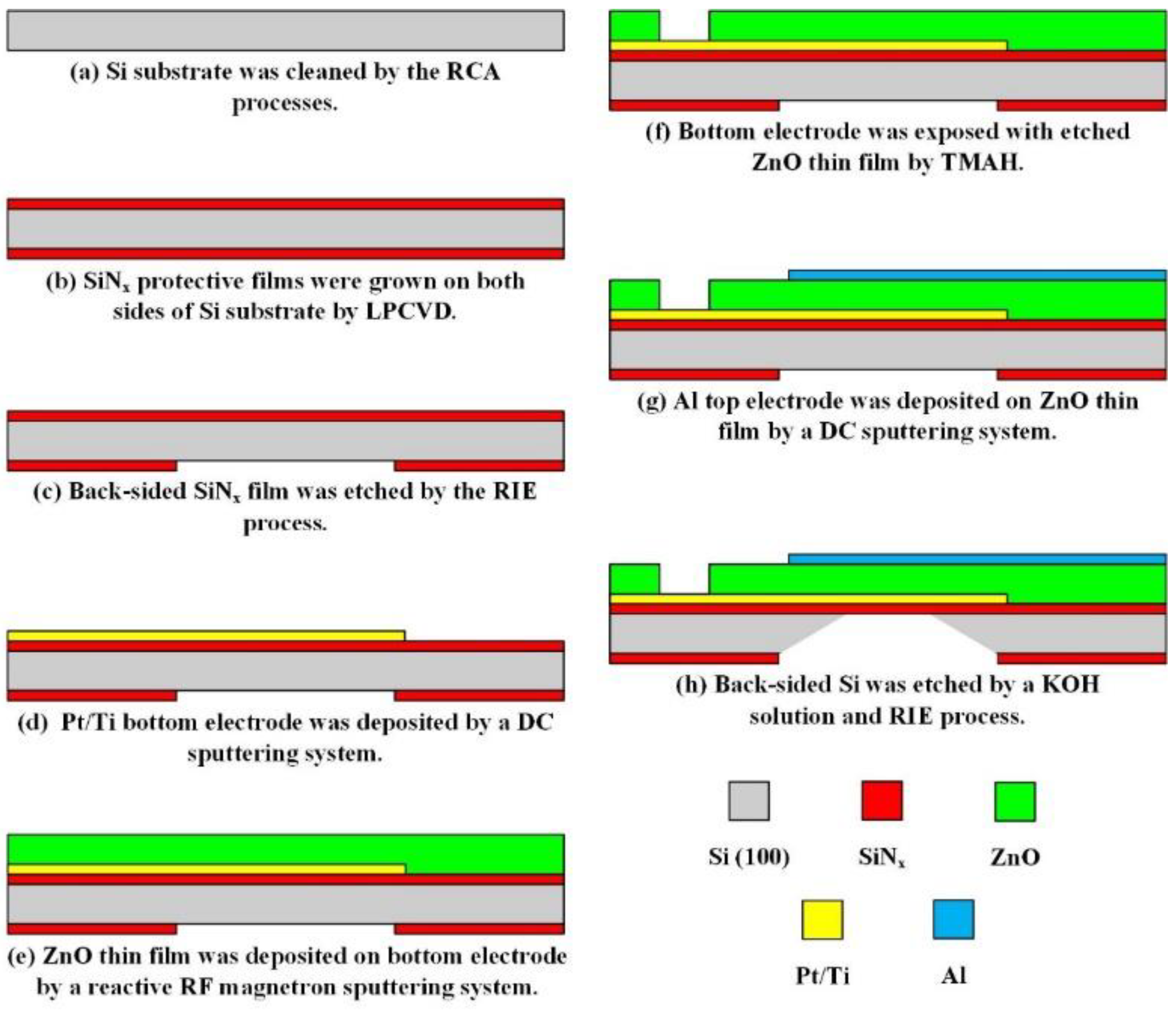
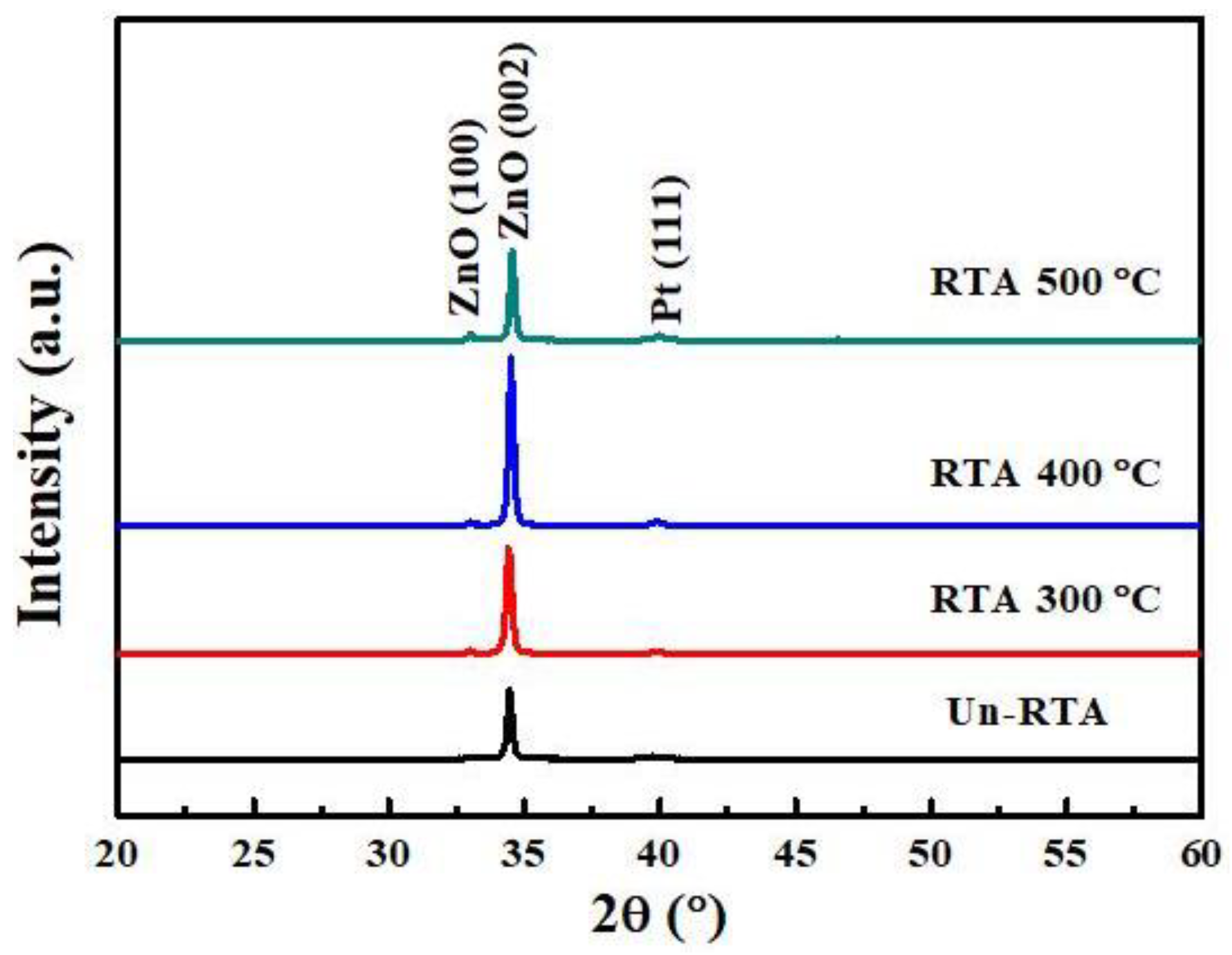

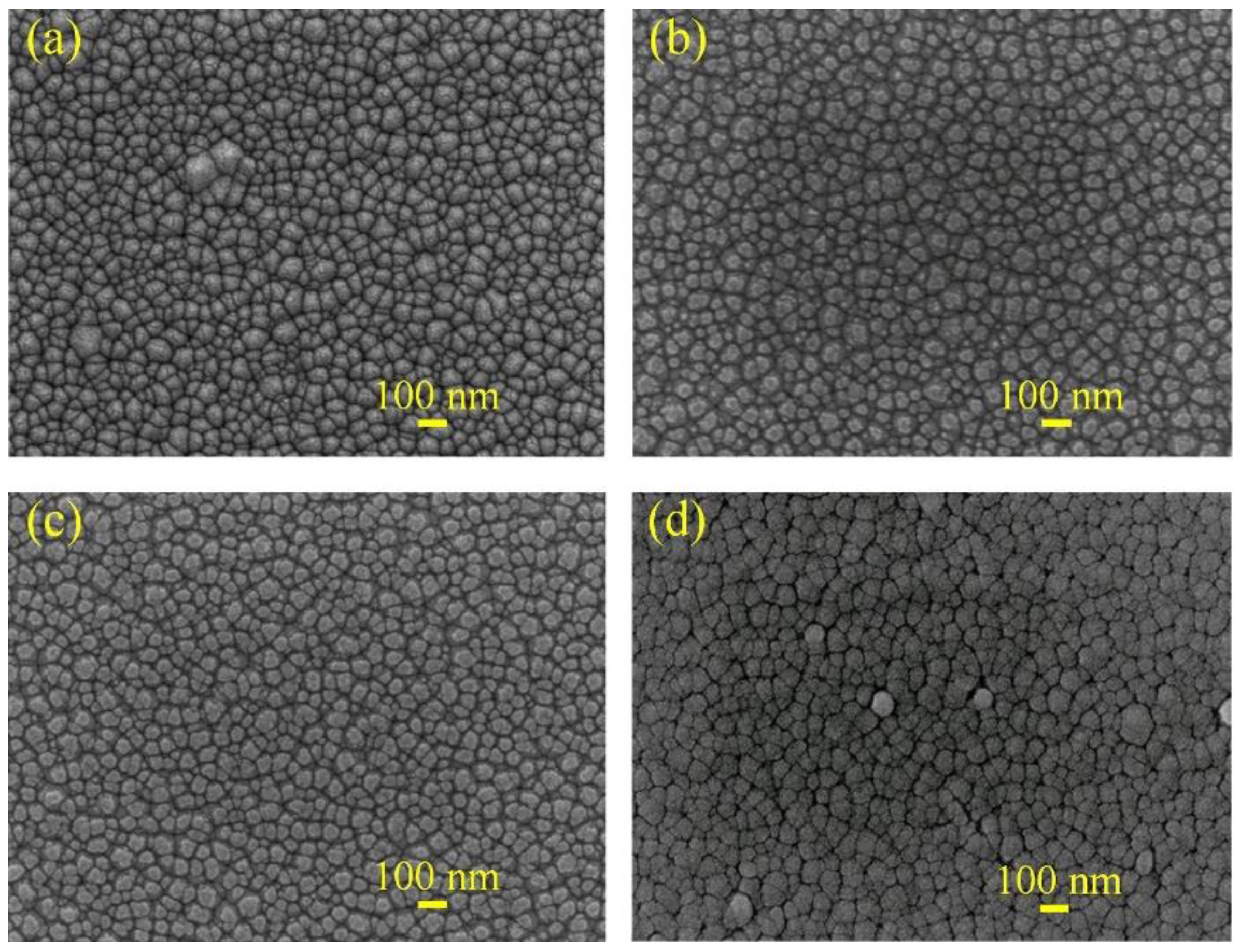
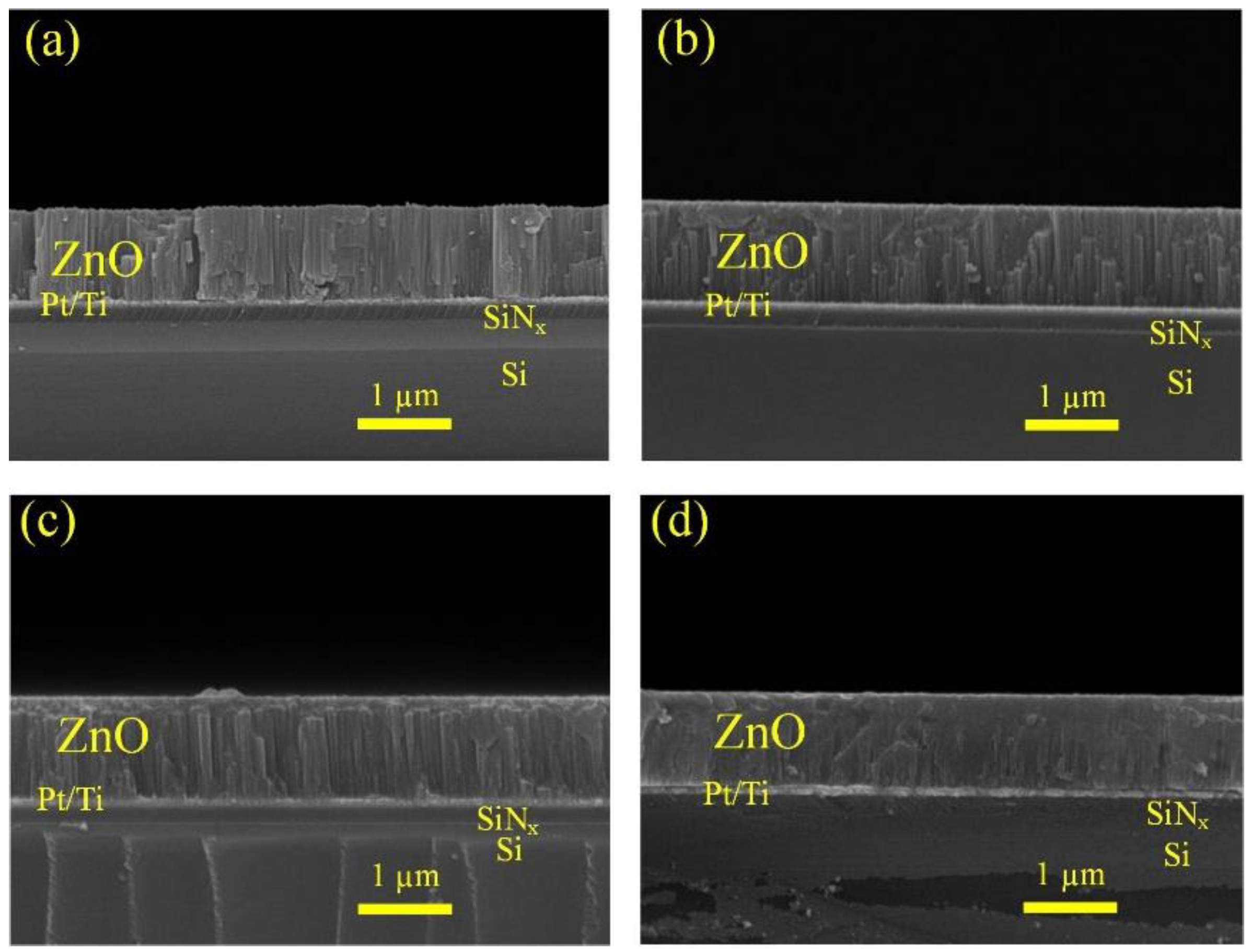
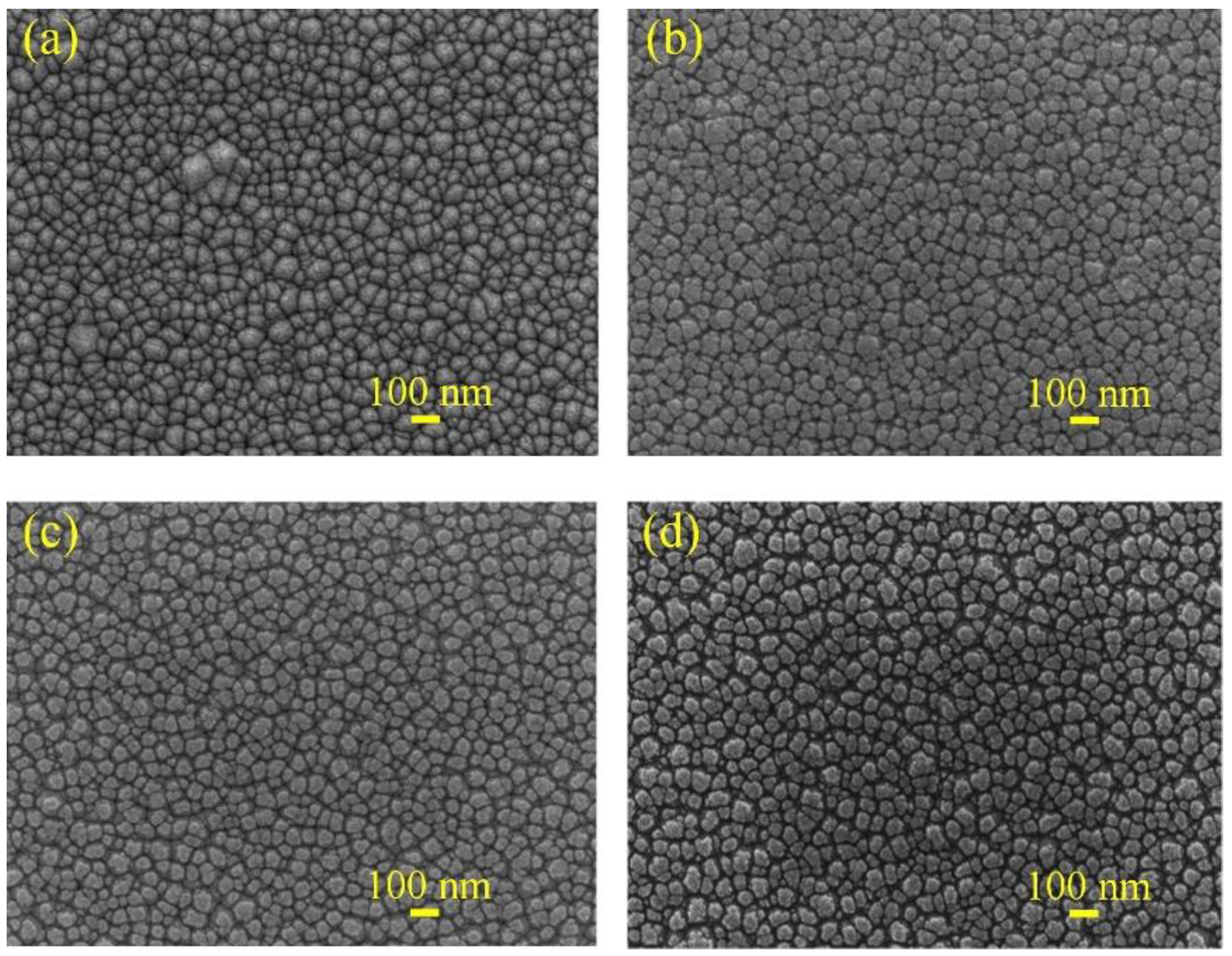

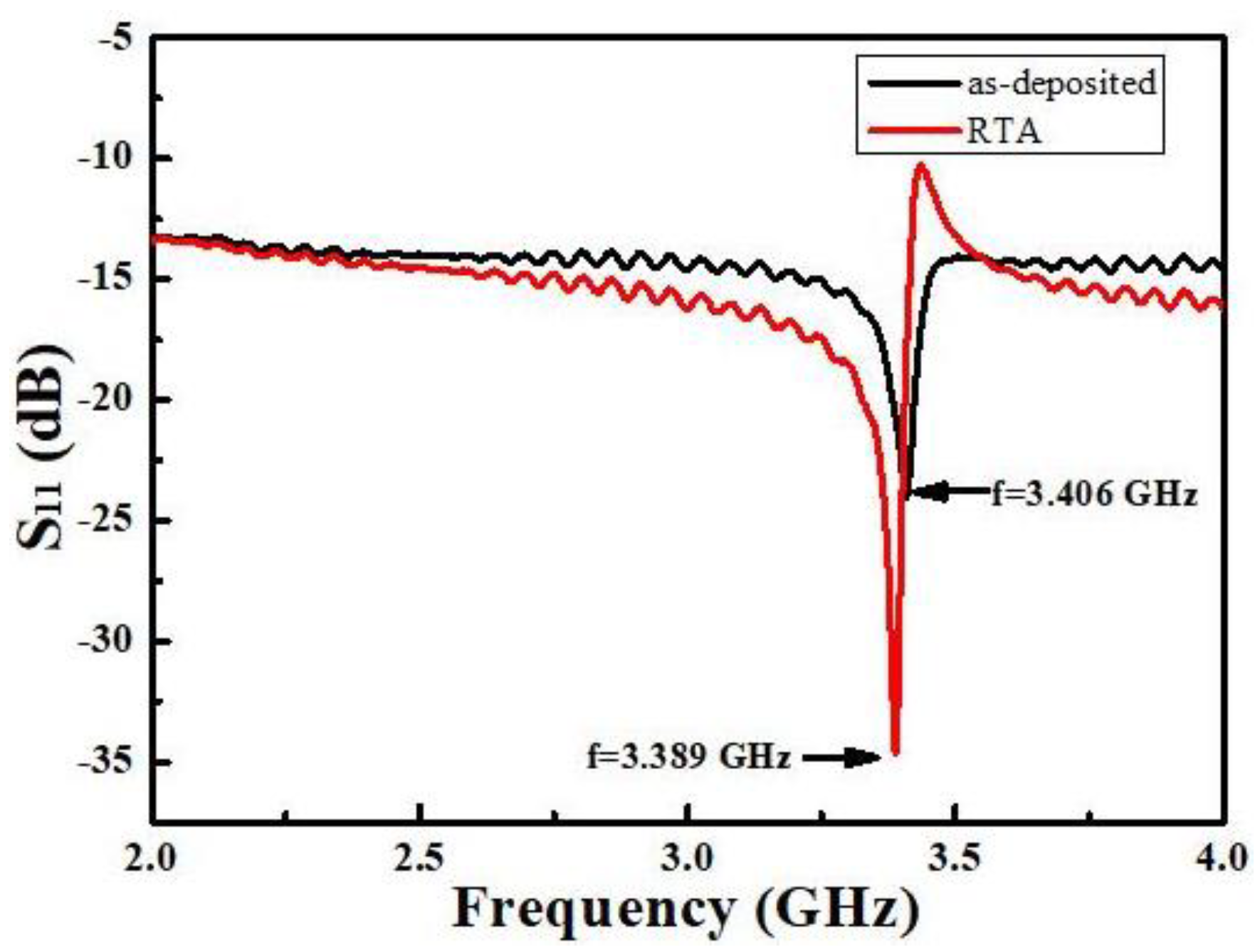
| DC Sputtering System | |||
|---|---|---|---|
| Target (2 inch) | Ti (99.995%) | Pt (99.95%) | Al (99.999%) |
| Substrate | SiNx/Si | Ti/SiNx/Si | ZnO/Pt/Ti/SiNx/Si |
| Base pressure (Torr) | <5 × 10−6 | <5 × 10−6 | <5 × 10−6 |
| Working pressure (mTorr) | 3 | 1 | 1 |
| Sputtering power (W) | 75 | 175 | 100 |
| Substrate temperature (°C) | R. T. | R. T. | R. T. |
| Ar flow (sccm) | 10 | 10 | 10 |
| Thickness (nm) | 12 | 100 | 100 |
| RF Magnetron Sputtering System | |
|---|---|
| Target (2 inch) | Zn (99.999%) |
| Substrate | Pt/Ti/SiNx/Si |
| Base pressure (Torr) | <1 × 10−6 |
| Working pressure (mTorr) | 20 |
| Sputtering power (W) | 80 |
| Substrate temperature (°C) | R. T. |
| O2/(O2 + Ar) (%) | 75 |
| Annealing time (min) | 5, 10, 15 |
| Annealing temperature (°C) | 300, 400, 500 |
| RTA Temperature (°C) | Grain Size (nm) | FWHM (°) |
|---|---|---|
| As-deposited | 36 | 0.24 |
| 300 | 36 | 0.24 |
| 400 | 39 | 0.21 |
| 500 | 41 | 0.20 |
| RTA Time (min) | Grain Size (nm) | FWHM (°) |
|---|---|---|
| As-deposited | 36 | 0.24 |
| 5 | 38 | 0.22 |
| 10 | 39 | 0.21 |
| 15 | 35 | 0.24 |
Publisher’s Note: MDPI stays neutral with regard to jurisdictional claims in published maps and institutional affiliations. |
© 2021 by the authors. Licensee MDPI, Basel, Switzerland. This article is an open access article distributed under the terms and conditions of the Creative Commons Attribution (CC BY) license (https://creativecommons.org/licenses/by/4.0/).
Share and Cite
Chang, Y.-C.; Chen, Y.-C.; Li, B.-R.; Shih, W.-C.; Lin, J.-M.; Chang, W.-T.; Cheng, C.-C. Effects of Thermal Annealing on the Characteristics of High Frequency FBAR Devices. Coatings 2021, 11, 397. https://doi.org/10.3390/coatings11040397
Chang Y-C, Chen Y-C, Li B-R, Shih W-C, Lin J-M, Chang W-T, Cheng C-C. Effects of Thermal Annealing on the Characteristics of High Frequency FBAR Devices. Coatings. 2021; 11(4):397. https://doi.org/10.3390/coatings11040397
Chicago/Turabian StyleChang, Yu-Chen, Ying-Chung Chen, Bing-Rui Li, Wei-Che Shih, Jyun-Min Lin, Wei-Tsai Chang, and Chien-Chuan Cheng. 2021. "Effects of Thermal Annealing on the Characteristics of High Frequency FBAR Devices" Coatings 11, no. 4: 397. https://doi.org/10.3390/coatings11040397
APA StyleChang, Y.-C., Chen, Y.-C., Li, B.-R., Shih, W.-C., Lin, J.-M., Chang, W.-T., & Cheng, C.-C. (2021). Effects of Thermal Annealing on the Characteristics of High Frequency FBAR Devices. Coatings, 11(4), 397. https://doi.org/10.3390/coatings11040397





